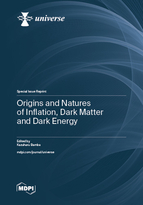Origins and Natures of Inflation, Dark Matter and Dark Energy
A special issue of Universe (ISSN 2218-1997). This special issue belongs to the section "Cosmology".
Deadline for manuscript submissions: closed (30 November 2022) | Viewed by 18204
Special Issue Editor
Interests: particle cosmology; gravity theory; inflation; late time acceleration
Special Issues, Collections and Topics in MDPI journals
Special Issue Information
Dear Colleagues,
Exploring the origins of a field to realize inflation, dark matter, and dark energy is one of the most important problems in modern physics and cosmology. The future detection of primordial gravitational waves is strongly expected to reveal the energy scale of inflation in the early universe. Furthermore, there are two possibilities for the origin of dark matter, namely, new particles in particle-theory models beyond the standard model, and astrophysical objects. In addition, two representative studies have been proposed for the true character of dark energy, the existence of which leads to late-time cosmic acceleration. One is to introduce some unknown matter called dark energy with the negative pressure in general relativity. The other is to modify gravity at large scales. The latter is called geometrical dark energy. The main aim of this Special Issue is to understand the origins and true natures of inflation, dark matter, and dark energy. We can consider both phenomenological approaches and more fundamental physics such as higher-dimensional gravity theories, quantum gravity, quantum cosmology, physics in the early universe, quantum field theories and gauge field theories in curved spacetime, string theories, brane world models, and the holographic principle. It is our pleasure to invite submissions to this Special Issue on inflation, dark matter, dark energy, and related foundations of physics.
Prof. Dr. Kazuharu Bamba
Guest Editor
Manuscript Submission Information
Manuscripts should be submitted online at www.mdpi.com by registering and logging in to this website. Once you are registered, click here to go to the submission form. Manuscripts can be submitted until the deadline. All submissions that pass pre-check are peer-reviewed. Accepted papers will be published continuously in the journal (as soon as accepted) and will be listed together on the special issue website. Research articles, review articles as well as short communications are invited. For planned papers, a title and short abstract (about 100 words) can be sent to the Editorial Office for announcement on this website.
Submitted manuscripts should not have been published previously, nor be under consideration for publication elsewhere (except conference proceedings papers). All manuscripts are thoroughly refereed through a single-blind peer-review process. A guide for authors and other relevant information for submission of manuscripts is available on the Instructions for Authors page. Universe is an international peer-reviewed open access monthly journal published by MDPI.
Please visit the Instructions for Authors page before submitting a manuscript. Submitted papers should be well formatted and use good English. Authors may use MDPI's English editing service prior to publication or during author revisions.
Keywords
- inflation
- dark matter
- dark energy
- modified gravity
- cosmology






